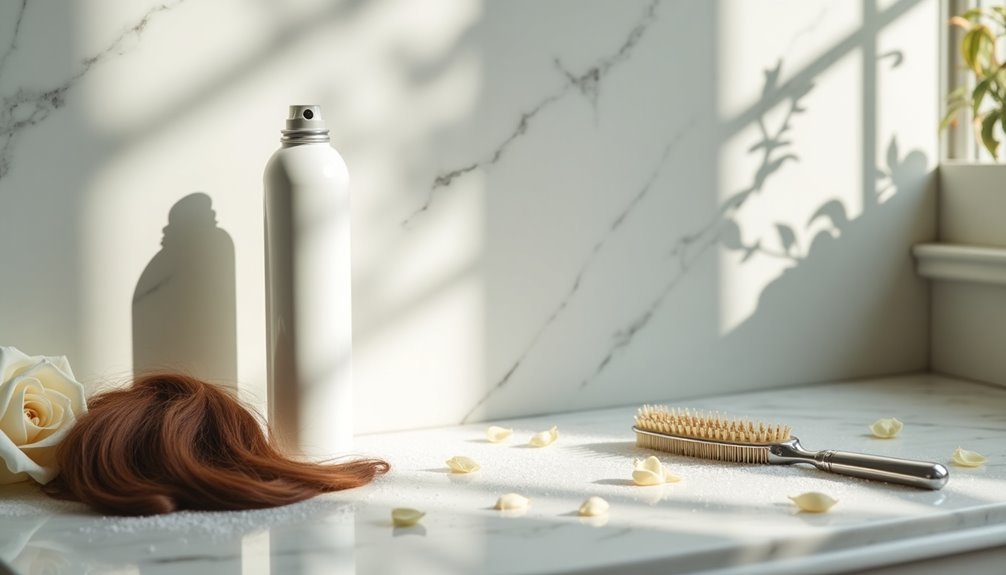For oily hair, you'll want a dry shampoo containing rice starch, silica, or clay minerals that effectively absorb excess sebum. Look for aerosol formulas that deliver a fine mist, which allows for even distribution and prevents visible residue. When applying, section your hair and spray from 6-8 inches away, focusing on the roots where oil tends to accumulate. Let the product sit for 2-3 minutes before massaging it into your scalp to maximize absorption. Natural alternatives like cornstarch-based options can work well too, especially when enhanced with essential oils. Understanding proper application techniques will help you get the most from your chosen formula.
Key Takeaways
- Look for dry shampoos containing rice starch or silica as main ingredients, as these are most effective at absorbing excess oil.
- Choose aerosol formulas for better distribution and even coverage when dealing with very oily roots.
- Tinted dry shampoos are ideal for dark hair to avoid white residue while effectively absorbing oil.
- Apply product in sections, focusing on the roots, and allow 2-3 minutes absorption time before massaging.
- Consider non-aerosol powder formulas for maximum oil absorption and better control over product application in specific areas.
What Makes Dry Shampoo Work
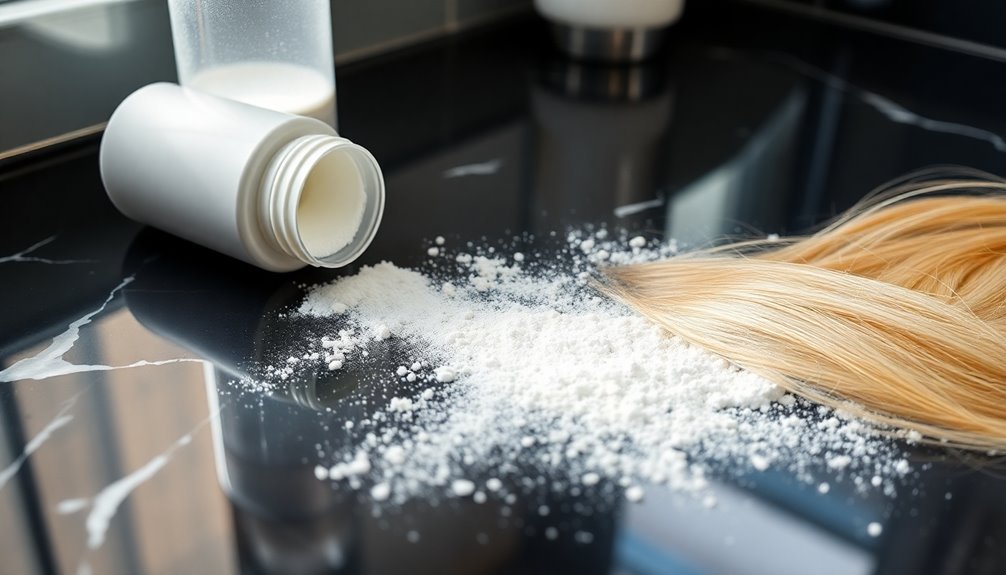
A cloud of dry shampoo can transform greasy, limp hair into a fresh, voluminous style in minutes. The science behind this beauty staple lies in its powerful capability to absorb excess oil and refresh your scalp without water. When you spray or dust the product onto your roots, specialized ingredients like rice starch and oat milk immediately begin working to control oil and odors.
Your volumizing dry shampoo works through a combination of ultra-fine powders and starches that attach themselves to oils on your scalp and hair shaft. These ingredients create a temporary barrier that soaks up sebum while adding much-needed lift at the roots.
As you massage the product into your scalp, it'll distribute evenly throughout your strands, transforming flat, oily sections into refreshed, manageable hair.
The key to effectiveness lies in the formulation's ability to balance oil control with scalp health. Premium dry shampoos often include ingredients like silica for superior oil absorption, while soothing components such as oat milk help maintain your scalp's natural moisture balance. This dual-action approach guarantees you'll get both immediate refreshment and lasting benefits throughout the day.
Incorporating probiotic-rich ingredients in your diet can further improve your scalp's health, as studies suggest probiotics can enhance overall well-being and potentially benefit your hair.
How to apply dry shampoo
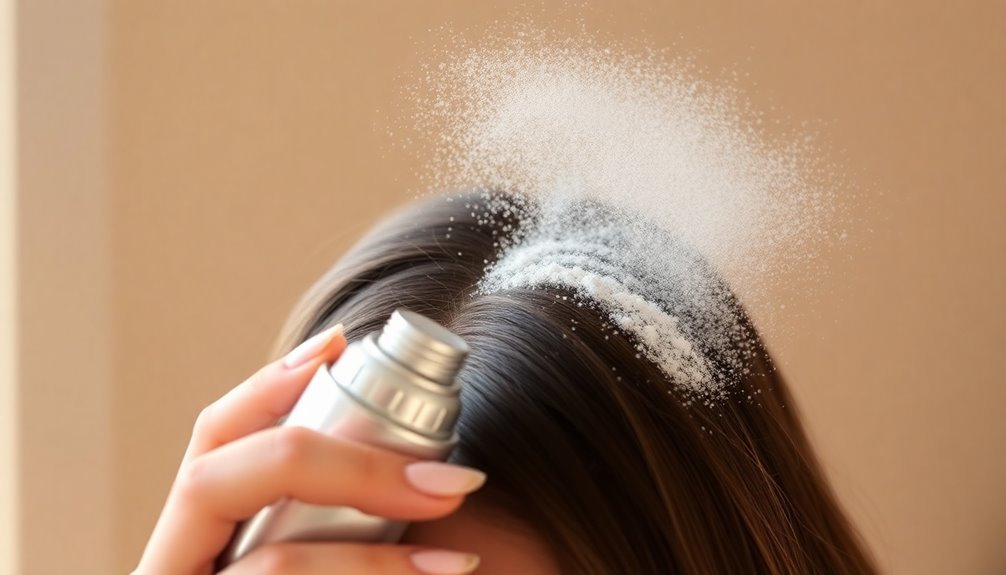
Now that you understand how dry shampoo works, mastering the application technique will maximize its oil-fighting power. To properly apply dry shampoo, you'll need to start by shaking the bottle thoroughly, which guarantees the active ingredients are well-mixed and ready for even distribution throughout your oily hair.
For best results, follow these essential steps:
- Hold the dry shampoo bottle 6-8 inches from your scalp, maintaining this distance to prevent product buildup and white residue.
- Section your hair strategically, working from the roots outward to target the most oil-prone areas effectively.
- Let the product sit for 2-3 minutes to properly absorb excess oil before touching your hair.
- Massage the product into your scalp with your fingertips, then brush through to distribute evenly.
Additionally, consider how patient lifestyle factors can affect hair care routines to further enhance the benefits of dry shampoo.
After application, you'll notice your hair looking fresh and clean without any chalky residue.
Remember to focus the product application on your roots, where oil tends to accumulate most, and work in small sections to guarantee thorough coverage. This methodical approach helps extend the time between regular washes while maintaining a polished appearance.
Different types of dry shampoo
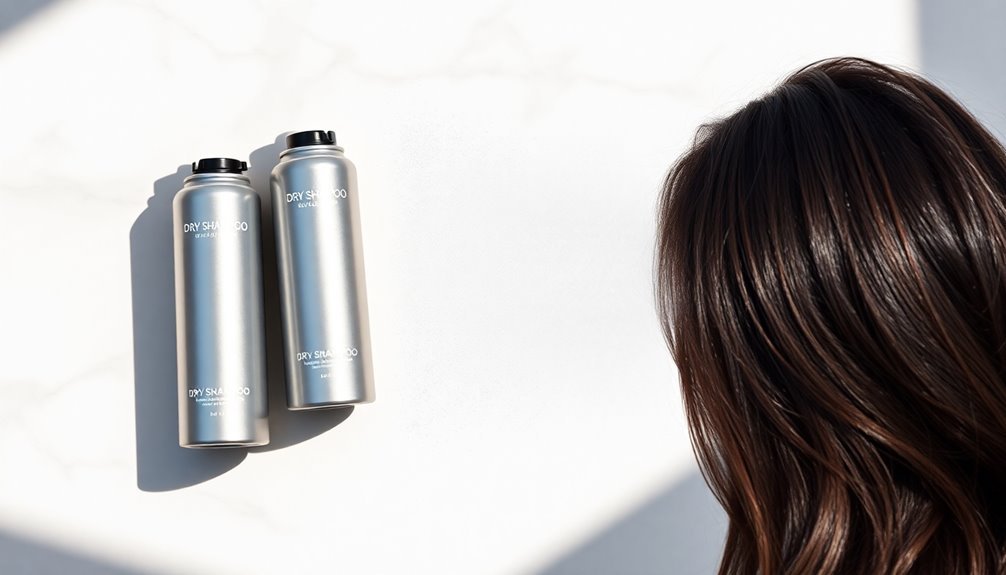
Modern dry shampoos come in several distinct formulations, each designed to tackle oily hair through different delivery methods and ingredients. The most common type is the aerosol spray, which delivers a fine mist of oil-absorbing powders directly to your roots and provides quick, even coverage.
You'll find that these sprays often contain rice starch or similar ingredients that effectively combat excess oil while adding volume to your hair.
If you're looking for more control over application, you might prefer a non-aerosol version, which includes loose powders and cream-based formulas. These options let you target specific areas of your scalp and often provide superior oil absorption compared to their aerosol counterparts.
For those with darker hair, tinted dry shampoos are specifically formulated to blend seamlessly with your natural color, preventing the chalky residue that can sometimes occur with traditional formulas.
Additionally, specialized versions containing ingredients like oat milk offer added benefits beyond oil control, such as scalp soothing and texture enhancement.
When selecting a dry shampoo, consider your hair type and specific needs to determine which formulation will work best for your daily routine. It's also beneficial to be aware of high-sugar foods that may disrupt our body's balance, as overall gut health plays a role in skin and hair conditions.
Application Tips and Common Mistakes
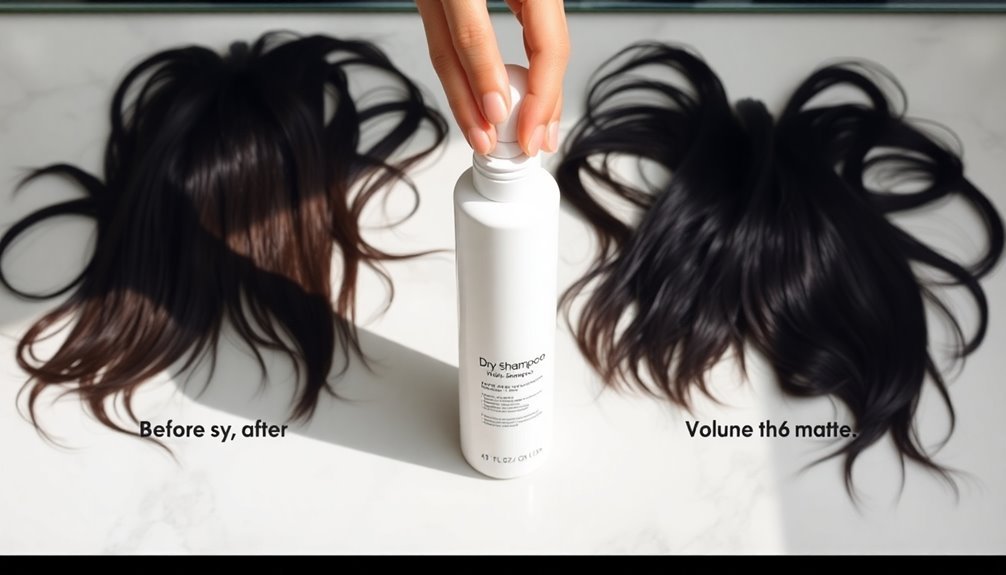
Getting the most from your chosen dry shampoo formula depends heavily on proper application techniques. When using dry shampoo for oily hair, you'll want to start with completely dry strands and shake the product thoroughly before each use to guarantee even distribution. A healthy relationship with our physical appearance and grooming habits is an important aspect of self-love and personal care. By following proper application methods, you'll maximize the product's ability to absorb oil while avoiding common pitfalls that can leave your hair looking dull or chalky.
- Hold the dry shampoo bottle 6-8 inches away from your scalp, applying in short bursts rather than continuous sprays to prevent product buildup.
- Section your hair strategically, focusing on the roots where oil tends to accumulate most heavily.
- Allow the product to sit for 2-3 minutes before massaging it into your scalp with your fingertips.
- Work through your hair with a clean brush to distribute the product evenly and remove any excess powder.
Avoid common application mistakes like applying to wet hair, spraying too close to the scalp, or using excessive amounts of product.
Instead, start with a light application and layer more as needed to achieve ideal oil absorption without creating residue.
Natural Dry Shampoo Alternatives
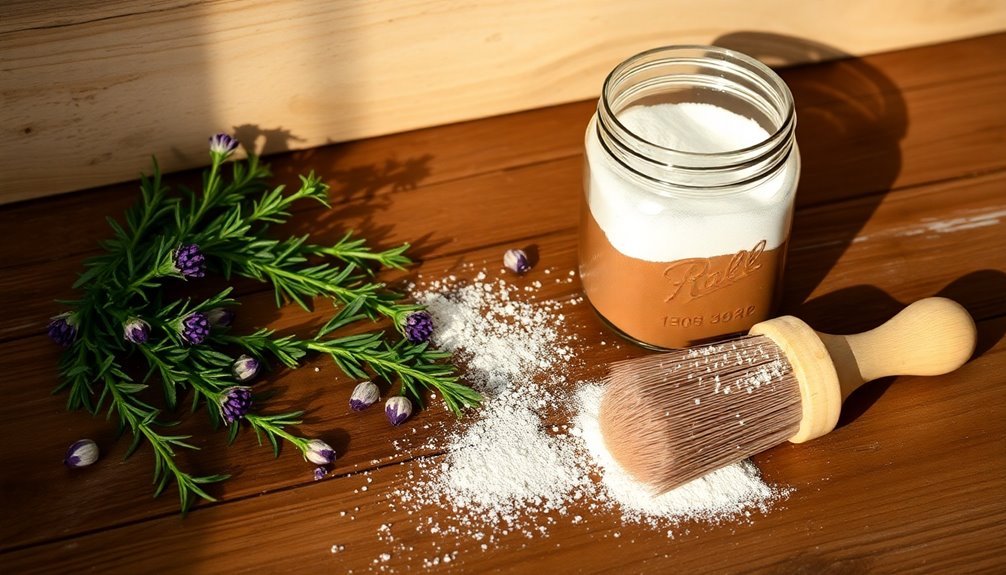
Natural beauty enthusiasts seeking an alternative to commercial dry shampoos can create effective solutions using simple pantry ingredients. A basic natural dry shampoo can be made by combining cornstarch or arrowroot powder, which absorbs excess oil efficiently while maintaining your hair's natural balance.
You'll find these ingredients are gentle on your scalp and won't strip away beneficial oils that contribute to overall hair health. To customize your DIY formula, you can add essential oils like lavender or peppermint for a pleasant fragrance and additional cleansing benefits.
If you're concerned about visible residue, you'll want to match the powder color to your hair tone – try adding cocoa powder for darker hair or stick with plain cornmeal for lighter shades. This eco-friendly solution eliminates the need for aerosol propellants and artificial ingredients found in commercial products.
Regular use of natural alternatives can help extend the time between traditional washes, reducing potential damage from frequent shampooing. You'll notice that these homemade versions aren't only cost-effective but also align with sustainable beauty practices, making them an excellent choice for environmentally conscious consumers.
Frequently Asked Questions
What Is the Best Dry Shampoo for Really Oily Hair?
You'll find Klorane Extra Gentle Dry Shampoo works best for really oily hair. Its lightweight oat milk formula absorbs excess oil effectively, keeping your hair fresh without leaving any heavy residue.
Does Dry Shampoo Work on Greasy Hair?
Yes, dry shampoo works effectively on greasy hair. You'll notice it absorbs excess oil, refreshes your scalp, and adds volume. Just spray it on your roots, wait a few minutes, and brush through.
Can Dry Shampoo Get Oil Out of Hair?
Yes, dry shampoo can effectively remove excess oil from your hair. It uses absorbing ingredients like starches to soak up grease, leaving your hair looking fresher and feeling cleaner between washes.
How Do You Fix Greasy Hair Without Washing It?
Need a quick fix for greasy locks? You'll want to use dry shampoo at your roots, massage it in thoroughly, and let it sit. Don't forget to brush through your hair afterward.
Conclusion
Just as a gardener knows the right soil keeps plants thriving, you'll find that choosing the perfect dry shampoo is essential for maintaining fresh, oil-free hair. You've learned the science behind oil absorption, mastered proper application techniques, and discovered both commercial and natural options. Now you're equipped to make informed decisions about which dry shampoo will work best for your hair type, helping you maintain that clean, volumized look between washes.

